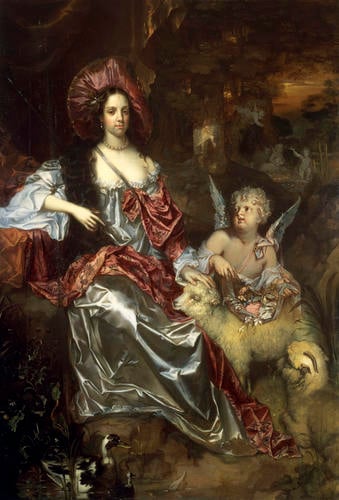-
1 of 253523 objects
Catherine of Braganza (1638-1705) c. 1662-64
Oil on canvas | 216.5 x 148.8 cm (support, canvas/panel/stretcher external) | RCIN 405665

Jacob Huysmans (c. 1633-96)
Catherine of Braganza (1638-1705) c. 1662-64
-
This portrait was painted for the Catherine of Braganza or her husband Charles II soon after their marriage. Negotiations for the marriage of Charles II and the Portuguese Infanta Catherine of Braganza began in 1660, with the king announcing his intentions at the opening of Parliament on 8 May 1661. Like his father's, Charles II's bride was Catholic, though the matter of religion was viewed as a secondary concern because Catherine brought with her a sizeable dowry, including the ports of Tangier and Bombay, along with 2 million cruzados (about £300,000). The marriage was supported by Charles's cousin Louis XIV, since it strengthened the French position against the common enemy, Spain, with England agreeing to protect Portugal from Spanish attack.
Charles's first impressions of his bride upon her arrival in England were favourable, as recorded in a letter to the Earl of Clarendon: 'her face is not so exact as to be called a beauty, though her eyes are excellent good […] she has as much agreeableness n her looks altogether, as ever I saw'. Similarly, John Evelyn recorded in his diary entry for 30 May 1662: 'she was yet of the handsomest Countenance of all the rest, & tho low of stature pretily shaped, languishing & excellent Eyes, her teeth wronging her mouth by stiking a little too far out: or the rest sweete & lovely enough' Catherine's influence at court was limited due to the lack of an heir, and she was frequently humiliated by the king's relationships with his mistresses. Despite this, she had her supporters and found some pleasure at court. She was given a pet monkey by Lady Arlington, and during the summer was presented with baskets of fruit.
Huysmans, a Flemish Catholic, was Catherine's preferred artist and helped to create her own visual identity. In this portrait, painted shortly after her marriage, Huysmans has portrayed Catherine as a shepherdess, surrounded by references to love and fertility, such as the sprig of orange blossom in her hair, the ewe with its lamb, which may represent the virtues of innocence, purity and humility, and the overflowing assortment of flowers held by the putto, all of which express the hope for a fruitful marriage. The queen is depicted as a sensuous beauty in a sumptuous silvery dress, her abundant hair flowing over her shoulder, in sharp contrast to portraits of her on her arrival, in which she is shown with an old-fashioned, Portuguese hairstyle.
The artist made a number of changes to the composition. The shepherdess's crook, which is now behind her, seems originally to have been supported in Catherine's right arm and there also seem to have been changes to the draperies round the Queen's left shoulder and arm.
Samuel Pepys, the diarist, saw the painting on 26 August 1664 when he visited Jacob Huysman's studio to see 'some pictures…The Queene is drawne in one like a shepherdess…'. As one of Huysman's most important portraits of his patroness it served as the source for some of his smaller portraits of her. A version of the whole composition, with Windsor Castle in the background, is now at Schloss Friedrichshof in Germany.
Text adapted from Charles II: Art and Power, London, 2017.Provenance
Painted for the sitter or her husband, Charles II; recorded in the Queen's Gallery at Hampton Court in 1666 (no 12) and 1688 (no 878); at St James's Palace in the Great Drawing Room in 1710 (no 6) until 1785; in the Gallery at St James's in 1819 (no 1018)
-
Medium and techniques
Oil on canvas
Measurements
216.5 x 148.8 cm (support, canvas/panel/stretcher external)
216.5 x 134.5 cm (support (etc), excluding additions)